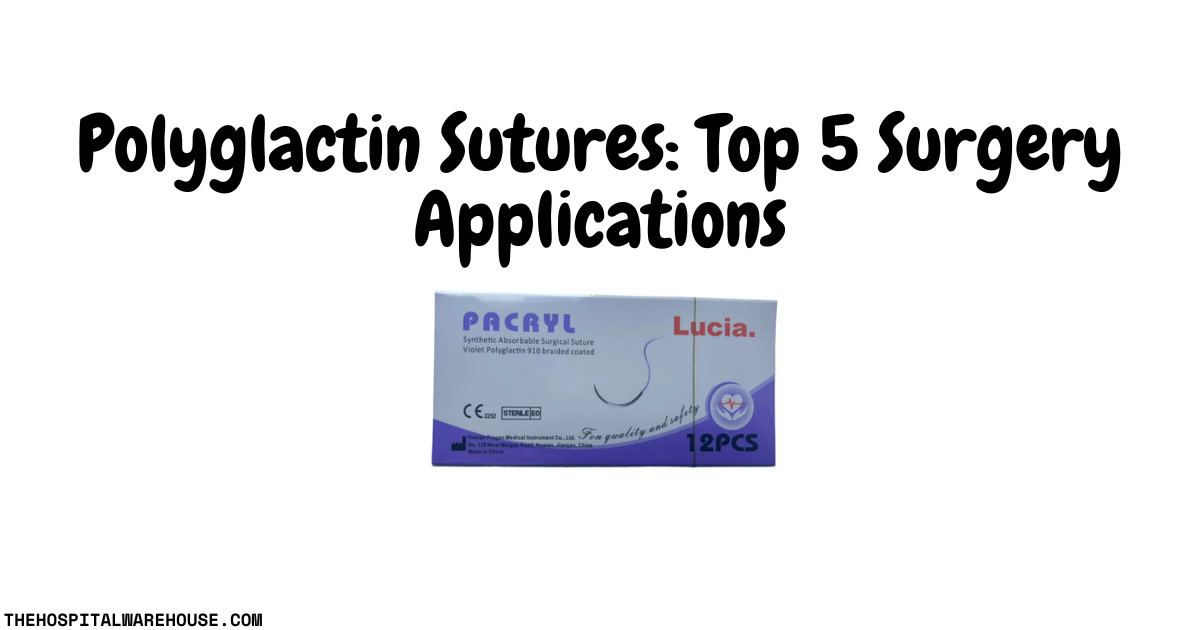
Top 5 Surgeries Where Polyglactin Sutures Are Commonly Used
Modern surgical practice has revolutionized patient care through innovative materials and techniques. Among these advances, polyglactin sutures have emerged as a cornerstone of successful surgical outcomes. These absorbable synthetic sutures offer surgeons the perfect balance of strength, predictable absorption, and minimal tissue reaction, making them indispensable across numerous medical specialties.
The beauty of polyglactin lies in its ability to maintain wound integrity during the critical healing phase while gradually dissolving as the body's natural healing processes take over. This eliminates the need for suture removal in many cases, reducing patient discomfort and follow-up visits while minimizing the risk of infection.
1. Gynecology and Obstetrics: The Foundation of Women's Health
Gynecological and obstetric procedures represent one of the largest applications for polyglactin sutures in modern medicine. These specialties demand materials that can handle the unique healing requirements of reproductive tissues while ensuring patient comfort during recovery.
Cesarean Sections: During C-sections, polyglactin sutures are the gold standard for closing uterine incisions. The sutures provide excellent tensile strength during the initial healing phase, typically maintaining their integrity for 2-3 weeks before beginning absorption. This timing perfectly matches the uterine healing process, allowing the muscle tissue to regain strength while the suture gradually dissolves.
Episiotomies and Perineal Repairs: Following vaginal deliveries, polyglactin sutures excel in repairing episiotomies and natural tears. The material's smooth passage through delicate perineal tissues reduces trauma during suturing, while its predictable absorption pattern means mothers don't need to return for suture removal during their already busy postpartum period.
Hysterectomies: Whether performed abdominally or laparoscopically, hysterectomies rely heavily on polyglactin for internal tissue approximation. The sutures provide reliable closure of the vaginal cuff and other internal structures, with absorption occurring over 60-90 days as tissues fully heal and remodel.
The benefits in obstetrics and gynecology extend beyond convenience. Polyglactin's minimal inflammatory response is particularly valuable in these sensitive areas, where excessive scarring could impact future pregnancies or sexual function.
2. Gastrointestinal Surgery: Precision in Internal Healing
Gastrointestinal procedures present unique challenges that make polyglactin sutures particularly valuable. The digestive system's complex healing requirements, combined with the need for watertight closures and minimal foreign body reaction, make these absorbable sutures an obvious choice for GI surgeons.
Bowel Anastomoses: When connecting sections of intestine, surgeons rely on polyglactin for creating secure, leak-proof connections. The sutures maintain their strength long enough for the anastomosis to heal properly, typically 10-14 days, before beginning their absorption process. This timing is crucial because premature suture failure could lead to life-threatening complications like anastomotic leaks.
Gastric Procedures: From sleeve gastrectomies to gastric bypass surgeries, polyglactin sutures provide the reliability needed for stomach tissue repairs. The material's resistance to gastric acids during the critical healing period, combined with its eventual complete absorption, makes it ideal for these procedures.
Appendectomies: Whether performed open or laparoscopically, appendectomies benefit from polyglactin's ease of handling and knot security. The sutures effectively close the appendiceal stump and peritoneal layers while eliminating concerns about permanent foreign material in the abdomen.
Liver and Gallbladder Surgery: Hepatic procedures often involve polyglactin for parenchymal repairs and closure of liver capsule defects. The sutures provide hemostasis while gradually absorbing as the liver's remarkable regenerative capacity takes over.
The predictable absorption profile of polyglactin is particularly important in GI surgery because it eliminates the long-term risks associated with permanent sutures in the digestive tract, such as suture line granulomas or chronic inflammation.
3. Pediatric Surgeries: Gentle Care for Growing Bodies
Children's surgical needs require special consideration due to their delicate tissues, rapid healing capacity, and the psychological impact of medical procedures. Polyglactin sutures have become the preferred choice in pediatric surgery because they minimize trauma while providing optimal healing conditions.
Hernia Repairs: Pediatric hernias, particularly inguinal hernias in infants, are commonly repaired using polyglactin sutures. The material's smooth passage through delicate tissues reduces surgical trauma, while its absorption eliminates the need for suture removal visits that can be stressful for both children and parents.
Appendectomies in Children: Pediatric appendectomies benefit significantly from polyglactin's properties. Children heal faster than adults, and the sutures' absorption timeline aligns perfectly with pediatric healing patterns. The reduced inflammatory response also minimizes post-operative discomfort.
Soft Tissue Repairs: From minor lacerations to more complex soft tissue reconstructions, polyglactin sutures provide the ideal combination of strength and gentleness needed for pediatric patients. The material's flexibility accommodates the natural movement and growth of children's tissues.
Circumcisions: This common pediatric procedure relies on polyglactin for its hemostatic properties and comfortable healing. The sutures dissolve naturally as the tissue heals, eliminating the need for follow-up visits solely for suture removal.
The psychological benefits cannot be overstated. Parents appreciate not having to bring their children back for potentially traumatic suture removal procedures, while healthcare providers value the reduced risk of wound complications that can occur when children inadvertently disturb external sutures.
4. General Surgery: Versatility Across Procedures
General surgery encompasses a broad range of procedures, and polyglactin sutures have proven their versatility across this diverse field. From emergency trauma repairs to elective procedures, these sutures provide consistent, reliable performance that surgeons have come to depend on.
Hernia Repairs: Adult hernia repairs, including inguinal, umbilical, and incisional hernias, frequently utilize polyglactin sutures for tissue approximation and mesh fixation. The sutures provide initial structural support while tissues heal and remodel around mesh materials, then absorb completely to avoid long-term complications.
Thyroid Surgery: Thyroidectomies and other neck procedures benefit from polyglactin's smooth handling characteristics and minimal tissue reaction. The sutures effectively close deep tissues and muscle layers while their eventual absorption prevents palpable knots in this cosmetically sensitive area.
Breast Surgery: From lumpectomies to mastectomies, breast procedures rely on polyglactin for internal tissue approximation. The sutures' absorption eliminates concerns about permanent foreign material in breast tissue, which is particularly important given the need for ongoing cancer surveillance.
Wound Closure: Complex traumatic wounds often require multi-layered closures using polyglactin for deep tissue approximation. The sutures provide excellent knot security and maintain their strength throughout the critical healing period.
Abdominal Wall Closures: Laparotomy closures frequently incorporate polyglactin sutures for peritoneal and muscle layer approximation. The material's strength and absorption characteristics make it ideal for these high-tension applications.
The versatility of polyglactin in general surgery stems from its predictable behavior across different tissue types and healing environments, giving surgeons confidence in their choice regardless of the specific procedure.
5. Orthopedic Procedures: Supporting Musculoskeletal Healing
While orthopedic surgery might seem like an unlikely application for absorbable sutures, polyglactin has found important niches in musculoskeletal procedures where its unique properties provide significant advantages over permanent alternatives.
Soft Tissue Repairs: Muscle tears, tendon repairs, and ligament reconstructions often incorporate polyglactin sutures for tissue approximation and support. The sutures maintain their strength during the initial healing phase, typically 3-4 weeks, allowing tissues to regain their structural integrity before absorption begins.
Arthroscopic Procedures: Minimally invasive joint surgeries frequently use polyglactin for soft tissue repairs within joint spaces. The material's eventual complete absorption eliminates concerns about permanent foreign material in joints, which could potentially cause long-term irritation or mechanical problems.
Fascia Closures: Deep fascia repairs in orthopedic procedures benefit from polyglactin's ability to maintain wound integrity while accommodating the natural movement and stress patterns of musculoskeletal tissues.
Rotator Cuff Repairs: These common shoulder procedures often incorporate polyglactin sutures for tissue approximation and augmentation of primary repairs. The sutures provide temporary support while the natural healing process restores tissue strength.
Hand Surgery: Delicate hand procedures, including tendon repairs and soft tissue reconstructions, utilize polyglactin's fine handling characteristics and minimal inflammatory response to optimize functional outcomes.
The key advantage in orthopedic applications is polyglactin's ability to provide temporary mechanical support without creating permanent foreign body reactions that could interfere with joint function or tissue mobility over time.
Why Polyglactin Sutures Are Growing in Use Across Kenya
Kenya's healthcare system has witnessed a remarkable transformation in surgical practices, with polyglactin sutures playing an increasingly important role in this evolution. The growing adoption of these advanced suture materials reflects both improved access to quality surgical supplies and a deeper understanding of their clinical benefits.
Cost-Effectiveness in Practice: While polyglactin sutures may have a higher initial cost compared to traditional materials, they deliver significant cost savings through reduced complications and follow-up visits. Kenyan hospitals have reported decreased rates of wound infections and suture-related complications, translating to lower overall treatment costs and improved resource utilization.
Improved Patient Outcomes: Healthcare facilities across Kenya have documented better healing rates and higher patient satisfaction scores when using polyglactin sutures. The reduced need for suture removal visits is particularly beneficial in rural areas where patients may travel long distances to reach healthcare facilities.
Training and Education: As more Kenyan surgeons receive training in modern surgical techniques, the demand for high-quality suture materials has increased. Medical education programs now emphasize the importance of selecting appropriate suture materials for optimal patient outcomes.
Supply Chain Reliability: The establishment of reliable supply chains for polyglactin sutures has made these materials more accessible to healthcare facilities across the country. This improved availability has enabled more hospitals to standardize on high-quality suture materials.
International Standards: Kenya's push toward meeting international healthcare standards has driven the adoption of globally recognized suture materials like polyglactin. This alignment with international best practices benefits both local patients and medical tourism initiatives.
The trend toward polyglactin adoption represents a broader commitment to improving surgical care quality across Kenya's healthcare system, ensuring that patients receive the same high-standard materials used in leading medical centers worldwide.
Ensuring Your Facility Has Reliable Access to Quality Sutures
If your hospital or clinic regularly performs these procedures, you need reliable polyglactin sutures in stock. At The Hospital Warehouse, we offer bulk order discounts and fast delivery across Kenya, ensuring your surgical teams never run short of these essential materials.
Our polyglactin sutures meet international quality standards and come with full documentation for regulatory compliance. Whether you're performing one surgery per week or dozens per day, we have the inventory and logistics capabilities to meet your needs with competitive pricing that makes sense for Kenyan healthcare budgets.
Don't let suture shortages compromise patient care. Contact The Hospital Warehouse today to discuss your polyglactin suture requirements and discover how our bulk ordering programs can reduce your supply costs while ensuring consistent availability. Your patients deserve the best materials for their surgical procedures, and we're here to make that possible.

Leave a comment